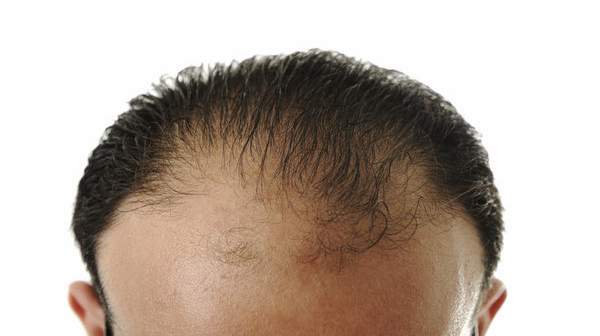What's in this article?
Hair loss or baldness (technically known as alopecia) is a loss of hair from the head or body. Baldness can refer to general hair loss or androgenic alopecia (male pattern baldness). Some types of baldness can be caused by alopecia areata, an autoimmune disorder. The extreme forms of alopecia areata are alopecia totalis, which involves the loss of all head hair, and alopecia universalis, which involves the loss of all hair from the head and the body.
Baldness and hypotrichosis can have many causes, including fungal infection (tinea capitis), traumatic damage, such as by compulsive pulling (trichotillomania), as a result of radiotherapy or chemotherapy, and as a result of nutritional deficiencies such as iron, and as a result of autoimmune phenomena, including alopecia areata and hair loss associated with systemic lupus erythematosus.
Male pattern baldness is the most common type of hair loss in men.
What Causes Male Pattern Baldness?
Male pattern baldness is both genetic, and associated with the male sex hormones called androgens. Androgens have many functions, one of which is to regulate hair growth.
Each strand of your hair grows out of a little hole in your skin called a follicle. Normally, an individual strand of hair grows for two to six years, goes through a resting stage for several months, falls out, and is replaced by a new hair strand. With male pattern baldness, the hair follicle becomes smaller. It grows shorter and finer strands, and eventually stops growing hair altogether.
The common cause of male pattern baldness heredity is usually harmless. However, sometimes it has more serious causes, such as certain cancers, medications, thyroid conditions, and anabolic steroids. See your doctor if hair loss occurs after taking new medications or when it is accompanied by other health complaints.
Male pattern baldness is diagnosed by the pattern of hair loss. A medical history and exam may be performed to rule out health conditions, fungal conditions of the scalp, or nutritional disorders that may be responsible. Health conditions are suspected when the hair loss is accompanied by a rash, redness, pain, peeling of the scalp, hair breakage, patchy hair loss, or an unusual pattern of hair loss. A skin biopsy and blood tests also may be used to diagnose disorders responsible for the hair loss.
Symptoms Male Pattern Baldness
The typical pattern of male baldness begins at the hairline. The hairline gradually moves backward (recedes) and forms an “M” shape. Eventually the hair becomes finer, shorter, and thinner, and creates a U-shaped (or horseshoe) pattern of hair around the sides of the head.
Who gets male Pattern Baldness?
Nearly all men have some baldness by the time they are in their 60s. However, the age the hair loss starts is variable. About three in ten 30 year-olds and half of 50 year-olds are quite bald. Some women also develop a similar type of hair loss, mainly at the crown. Baldness in women is much more common after the menopause. About 13 in a 100 women have some baldness before the menopause, rising to 75 in a 100 over the age of 65.
Treatment of Male Pattern Baldness
Treatment is not necessary if you are comfortable with your appearance. Hair weaving, hairpieces, or change of hairstyle may disguise the hair loss. This is usually the least expensive and safest approach for male baldness.
Medications that treat male pattern baldness include:
- Minoxidil (Rogaine), a solution that is applied directly to the scalp to stimulate the hair follicles. It slows hair loss for many men, and some men grow new hair. Hair loss returns when you stop using this medicine.
- Finasteride (Propecia, Proscar), a pill that interferes with the production of a highly active form of testosterone that is linked to baldness. It slows hair loss. It works slightly better than minoxidil. Hair loss returns when you stop using this medicine.
Hair transplants consist of removing tiny plugs of hair from areas where the hair is continuing to grow and placing them in areas that are balding. This can cause minor scarring and possibly, infection. The procedure usually requires multiple sessions and may be expensive.
Suturing hair pieces to the scalp is not recommended. It can result in scars, infections, and abscess of the scalp. The use of hair implants made of artificial fibers was banned by the FDA because of the high rate of infection.
Who is at Risk?
Male pattern baldness can begin in your teenage years, but it more commonly occurs in adult men with the likelihood increasing with age. Genetics play a big role. Men who have close relatives particularly on the maternal side with male pattern baldness are at a higher risk.
Are there any complications from male pattern baldness?
Although male pattern baldness is a common and harmless condition, it can be linked to metabolic syndrome (the combination of obesity, diabetes, raised blood pressure and raised choleterol), resulting in an increased risk of heart disease. This link is most often seen in men who develop baldness at a relatively young age.
Women with male pattern baldness should be checked for causes of raised male hormone levels, such as polycystic ovary syndrome (a condition in which cysts develop in the ovaries).
When to Contact a Medical Professional
Call your doctor if:
- Your hair loss occurs in an atypical pattern, including rapid hair loss, widespread shedding, hair loss in patches, or hair breakage.
- Your hair loss occurs with itching, skin irritation, redness, scaling, pain, or other symptoms.
- Your hair loss begins after starting a medication.
- You want to treat your hair loss.






Hello.This post was extremely interesting, particularly because I was looking for thoughts on this topic last Thursday.
Hi there very nice web site!! Man .. Excellent
.. Amazing .. I will bookmark your site and take the feeds
also? I’m happy to seek out so many helpful information right here
in the post, we want develop extra techniques on this regard, thank you for sharing.
. . . . .